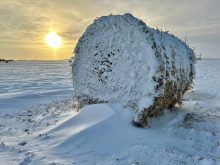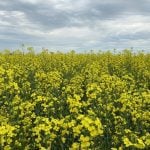Farmers in Manitoba are caught in their annual tug of war between attempts to prepare for spring operations and wildly variable weather.
Weather variablity at this time of year makes forecasting notoriously difficult, noted Alison Sass, an agriculture meteorology specialist with Manitoba Agriculture. Sass was a presenter during the province’s April 23 Crop Talk Webinar, a day after parts of western Manitoba were under a snowfall warning.
“Unfortunately, I can’t explain why we’re getting snow, but it’s not too unusual,” she said. “This time of year, spring can be really unpredictable in terms of precipitation … and knowing the types of precipitation that can occur.”
Read Also

Finally getting paid for sustainable farming?
Alberta project says they might have a line on a workable ecosystem credit model to reward farmers for sustainability, and Manitoba might be next
WHY IT MATTERS: Farmers in Manitoba are itching to get into the field to lay down fertilizer and seed, but swinging precipitation and temperature forecasts make go-time hard to anticipate.
Despite that, seeding progress via Manitoba’s first provincial crop report came in slightly ahead of the curve. The April 29 report noted that farm equipment had started to roll in some areas and that seeding was about three per cent complete, two points ahead of the five-year average. Peas, spring wheat and oats had gone into the ground in central and eastern Manitoba, as well as the Interlake.
Drawing data
Relying on past data to predict future weather is highly problematic, Sass noted. She pointed to last spring, which began with drought concerns, but quickly turned wet, delaying seeding and derailing the typical spray season in the first half of the summer.
“We had heavy rains throughout the province in both May and June, also higher than normal precipitation through April, and this did cause some delays in seeding progress due to the wet conditions,” Sass said.
The Winkler region, in particular, saw 226 per cent of its normal year-to-date rainfall at one point in the first half of the growing season.
“Just goes to show (that) precipitation could be very variable early on in the season, and we have yet to see what the season’s going to bring,” the meteorologist said.
Single-event storms can mask longer-term trends, she warned. Likewise, summing up precipitation across the entire season can’t say much about the intensity of rainfall or, given its timing in the season, how it impacted crops. A seasonal summary could show normal precipitation in an area, but neglect to show that most of the season in that region was dry, save for a few high-intensity events. Growing under those conditions would be very different than actual normal rainfall.
Coming into spring
Looking at last year’s weather, and where it leaves Manitoba’s agricultural ground this spring, Sass noted 2024’s temperature swings. Early summer saw cooler-than-normal conditions and an unusually warm September. September temperatures were nearly five degrees above the 30-year average in many regions, a record deviation. Wind was also more aggressive than typical.
“We did have higher than previous years in terms of the maximum wind speeds, especially in the Brandon and Forrest,” Sass said, adding that wind gusts exceeded 100 kilometres per hour at some stations during storms in June and October.
Going into winter, soil moisture was above average in many areas and a longer-than-usual frost-free period allowed for extended measurements. The RM of Woodlands and Lake Francis area in the Interlake, for example, reported 156 frost-free days last year.
With snowpack largely vanished, attention now turns to current moisture reserves. Some parts of the province are showing drier than normal, Sass said, but it’s too soon to start talking about drought.
“From my perspective, I’m not seeing drought-ish conditions,” Sass said. “However, saying that, there’s all different ways to categorize drought as well. So, when I’m speaking drought, I’m talking agricultural drought. So, is this going to impact crops?”
Environment and Climate Change Canada’s spring outlook shows a 70 to 80 per cent chance of above-normal temperatures in southern and central regions for April through June. However, these forecasts are inherently uncertain, Sass warned.
“Again, I’m going to provide the caveat that this is a three-month forecast, so it’s very long term and it’s very difficult to make accurate predictions this far in advance and it’s a probability.
“So, it’s saying there’s a pretty good chance that we’re going to see above normal temperatures, but it doesn’t say how much above those temperatures it’s going to be.”
Producers can monitor real-time data from the province’s 120-station weather monitoring network. Data updates every 15 minutes during the growing season. Special maps are also created for different weather events, including during the off season, Sass added.
















